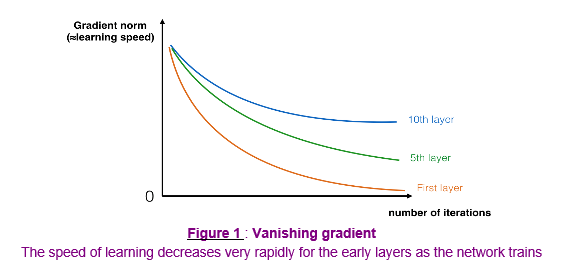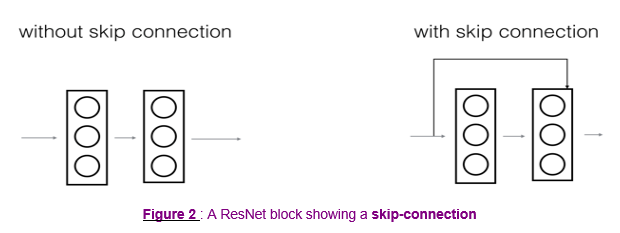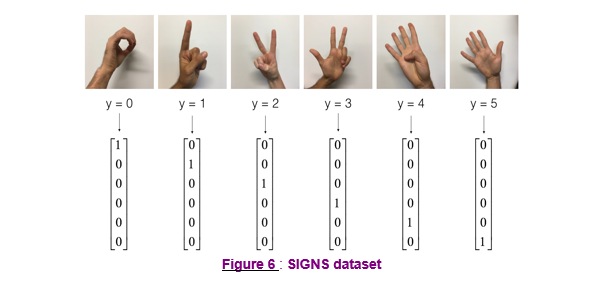DeepLearning.ai-Week2-Residual Networks
1 - Import Packages
import numpy as np
from keras import layers
from keras.layers import Input, Add, Dense, Activation, ZeroPadding2D, BatchNormalization, Flatten, Conv2D, AveragePooling2D, MaxPooling2D, GlobalMaxPooling2D
from keras.models import Model, load_model
from keras.preprocessing import image
from keras.utils import layer_utils
from keras.utils.data_utils import get_file
from keras.applications.imagenet_utils import preprocess_input
import pydot
from IPython.display import SVG
from keras.utils.vis_utils import model_to_dot
from keras.utils import plot_model
from resnets_utils import *
from keras.initializers import glorot_uniform
import scipy.misc
from matplotlib.pyplot import imshow
%matplotlib inline import keras.backend as K
K.set_image_data_format('channels_last')
K.set_learning_phase(1)
2 - The problem of very deep neural networks
更深的网络可以表示更复杂的函数,可以学习更多层次上的特征表示。但深层网络存在梯度消失或者梯度爆炸问题。随着训练的进行,可以看到网络前面的网络层的梯度迅速下降为0。构建$Residual Network$可以解决这个问题。

3 - Building a Residual Network
$Residual Network$中通过跳远连接(捷径)避免梯度消失/爆炸。跳远连接使得学习恒等函数也变得容易,所以更深的网络可以确保其效率和性能至少不低于比更浅的网络。

3.1 - The identity block


# GRADED FUNCTION: identity_block def identity_block(X, f, filters, stage, block):
"""
Implementation of the identity block as defined in Figure 3 Arguments:
X -- input tensor of shape (m, n_H_prev, n_W_prev, n_C_prev)
f -- integer, specifying the shape of the middle CONV's window for the main path
filters -- python list of integers, defining the number of filters in the CONV layers of the main path
stage -- integer, used to name the layers, depending on their position in the network
block -- string/character, used to name the layers, depending on their position in the network Returns:
X -- output of the identity block, tensor of shape (n_H, n_W, n_C)
""" # defining name basis
conv_name_base = 'res' + str(stage) + block + '_branch'
bn_name_base = 'bn' + str(stage) + block + '_branch' # Retrieve Filters
F1, F2, F3 = filters # Save the input value. You'll need this later to add back to the main path.
X_shortcut = X # First component of main path
X = Conv2D(filters = F1, kernel_size = (1, 1), strides = (1,1), padding = "valid", name = conv_name_base + "2a", kernel_initializer = glorot_uniform(seed=0))(X)
X = BatchNormalization(axis = 3, name = bn_name_base + "2a")(X)
X = Activation("relu")(X) ### START CODE HERE ### # Second component of main path (≈3 lines)
X = Conv2D(filters = F2, kernel_size = (f, f), strides = (1, 1), padding = "same", name = conv_name_base + "2b", kernel_initializer = glorot_uniform(seed=0))(X)
X = BatchNormalization(axis = 3, name = bn_name_base + "2b")(X)
X = Activation("relu")(X) # Third component of main path (≈2 lines)
X = Conv2D(filters = F3, kernel_size = (1, 1), strides = (1, 1), padding = "valid", name = conv_name_base + "2c", kernel_initializer = glorot_uniform(seed=0))(X)
X = BatchNormalization(axis = 3, name = bn_name_base + "2c")(X) # Final step: Add shortcut value to main path, and pass it through a RELU activation (≈2 lines)
X = Add()([X, X_shortcut])
X = Activation("relu")(X) ### END CODE HERE ### return X
Result:
out = [ 0.94822997 0. 1.16101444 2.747859 0. 1.36677003]
3.2 - The convolutional block

# GRADED FUNCTION: convolutional_block def convolutional_block(X, f, filters, stage, block, s = 2):
"""
Implementation of the convolutional block as defined in Figure 4 Arguments:
X -- input tensor of shape (m, n_H_prev, n_W_prev, n_C_prev)
f -- integer, specifying the shape of the middle CONV's window for the main path
filters -- python list of integers, defining the number of filters in the CONV layers of the main path
stage -- integer, used to name the layers, depending on their position in the network
block -- string/character, used to name the layers, depending on their position in the network
s -- Integer, specifying the stride to be used Returns:
X -- output of the convolutional block, tensor of shape (n_H, n_W, n_C)
""" # defining name basis
conv_name_base = 'res' + str(stage) + block + '_branch'
bn_name_base = 'bn' + str(stage) + block + '_branch' # Retrieve Filters
F1, F2, F3 = filters # Save the input value
X_shortcut = X ##### MAIN PATH #####
# First component of main path
X = Conv2D(F1, (1, 1), strides = (s, s), padding="valid", name = conv_name_base + "2a", kernel_initializer = glorot_uniform(seed=0))(X)
X = BatchNormalization(axis = 3, name = bn_name_base + "2a")(X)
X = Activation("relu")(X) ### START CODE HERE ### # Second component of main path (≈3 lines)
X = Conv2D(F2, (f, f), strides = (1, 1), padding="same", name = conv_name_base + "2b", kernel_initializer = glorot_uniform(seed=0))(X)
X = BatchNormalization(axis = 3, name = bn_name_base + "2b")(X)
X = Activation("relu")(X) # Third component of main path (≈2 lines)
X = Conv2D(F3, (1, 1), strides = (1, 1), padding="valid", name = conv_name_base + "2c", kernel_initializer = glorot_uniform(seed=0))(X)
X = BatchNormalization(axis = 3, name = bn_name_base + "2c")(X) ##### SHORTCUT PATH #### (≈2 lines)
X_shortcut = Conv2D(F3, (1, 1), strides = (s, s), padding="valid", name = conv_name_base + "", kernel_initializer = glorot_uniform(seed=0))(X_shortcut)
X_shortcut = BatchNormalization(axis = 3, name = bn_name_base + "")(X_shortcut) # Final step: Add shortcut value to main path, and pass it through a RELU activation (≈2 lines)
X = Add()([X, X_shortcut])
X = Activation("relu")(X) ### END CODE HERE ### return X
tf.reset_default_graph() with tf.Session() as test:
np.random.seed(1)
A_prev = tf.placeholder("float", [3, 4, 4, 6])
X = np.random.randn(3, 4, 4, 6)
A = convolutional_block(A_prev, f = 2, filters = [2, 4, 6], stage = 1, block = 'a')
test.run(tf.global_variables_initializer())
out = test.run([A], feed_dict={A_prev: X, K.learning_phase(): 0})
print("out = " + str(out[0][1][1][0]))
Result:
out = [ 0.09018463 1.23489785 0.46822023 0.03671762 0. 0.65516603]
4 - Building your first ResNet model (50 layers)
"ID BLOCK"代表"Identity block","ID BLOCK x3"代表需要堆叠3个"Identity block"在一起。

# GRADED FUNCTION: ResNet50 def ResNet50(input_shape = (64, 64, 3), classes = 6):
"""
Implementation of the popular ResNet50 the following architecture:
CONV2D -> BATCHNORM -> RELU -> MAXPOOL -> CONVBLOCK -> IDBLOCK*2 -> CONVBLOCK -> IDBLOCK*3
-> CONVBLOCK -> IDBLOCK*5 -> CONVBLOCK -> IDBLOCK*2 -> AVGPOOL -> TOPLAYER Arguments:
input_shape -- shape of the images of the dataset
classes -- integer, number of classes Returns:
model -- a Model() instance in Keras
""" # Define the input as a tensor with shape input_shape
X_input = Input(input_shape) # Zero-Padding
X = ZeroPadding2D((3, 3))(X_input) # Stage 1
X = Conv2D(64, (7, 7), strides = (2, 2), name = "conv1", kernel_initializer = glorot_uniform(seed=0))(X)
X = BatchNormalization(axis = 3, name = "bn_conv1")(X)
X = Activation("relu")(X)
X = MaxPooling2D((3, 3), strides=(2, 2))(X) # Stage 2
X = convolutional_block(X, f = 3, filters = [64, 64, 256], stage = 2, block="a", s = 1)
X = identity_block(X, 3, [64, 64, 256], stage=2, block='b')
X = identity_block(X, 3, [64, 64, 256], stage=2, block='c') ### START CODE HERE ### # Stage 3 (≈4 lines)
X = convolutional_block(X, f = 3, filters = [128, 128, 512], stage = 3, block = "a", s = 2)
X = identity_block(X, 3, [128, 128, 512], stage=3, block="b")
X = identity_block(X, 3, [128, 128, 512], stage=3, block="c")
X = identity_block(X, 3, [128, 128, 512], stage=3, block="d") # Stage 4 (≈6 lines)
X = convolutional_block(X, f = 3, filters = [256, 256, 1024], stage = 4, block = "a", s = 2)
X = identity_block(X, 3, [256, 256, 1024], stage=4, block="b")
X = identity_block(X, 3, [256, 256, 1024], stage=4, block="c")
X = identity_block(X, 3, [256, 256, 1024], stage=4, block="d")
X = identity_block(X, 3, [256, 256, 1024], stage=4, block="e")
X = identity_block(X, 3, [256, 256, 1024], stage=4, block="f") # Stage 5 (≈3 lines)
X = convolutional_block(X, f = 3, filters = [512, 512, 2048], stage = 5, block = "a", s = 2)
X = identity_block(X, 3, [512, 512, 2048], stage=5, block="b")
X = identity_block(X, 3, [512, 512, 2048], stage=5, block="c") # AVGPOOL (≈1 line). Use "X = AveragePooling2D(...)(X)"
X = AveragePooling2D(pool_size=(2, 2), name="avg_pool")(X) ### END CODE HERE ### # output layer
X = Flatten()(X)
X = Dense(classes, activation="softmax", name="fc" + str(classes), kernel_initializer = glorot_uniform(seed=0))(X) # Create model
model = Model(inputs = X_input, outputs = X, name="ResNet50") return model
model = ResNet50(input_shape = (64, 64, 3), classes = 6)
model.compile(optimizer='adam', loss='categorical_crossentropy', metrics=['accuracy'])
X_train_orig, Y_train_orig, X_test_orig, Y_test_orig, classes = load_dataset() # Normalize image vectors
X_train = X_train_orig/255.
X_test = X_test_orig/255. # Convert training and test labels to one hot matrices
Y_train = convert_to_one_hot(Y_train_orig, 6).T
Y_test = convert_to_one_hot(Y_test_orig, 6).T print ("number of training examples = " + str(X_train.shape[0]))
print ("number of test examples = " + str(X_test.shape[0]))
print ("X_train shape: " + str(X_train.shape))
print ("Y_train shape: " + str(Y_train.shape))
print ("X_test shape: " + str(X_test.shape))
print ("Y_test shape: " + str(Y_test.shape))
Result:
number of training examples = 1080
number of test examples = 120
X_train shape: (1080, 64, 64, 3)
Y_train shape: (1080, 6)
X_test shape: (120, 64, 64, 3)
Y_test shape: (120, 6)
SIGNS Dataset

model.fit(X_train, Y_train, epochs = 2, batch_size = 32)
Result:
Epoch 1/2
1080/1080 [==============================] - 245s 227ms/step - loss: 3.0501 - acc: 0.2611
Epoch 2/2
1080/1080 [==============================] - 240s 223ms/step - loss: 2.3643 - acc: 0.3185
preds = model.evaluate(X_test, Y_test)
print ("Loss = " + str(preds[0]))
print ("Test Accuracy = " + str(preds[1]))
Result:
120/120 [==============================] - 8s 68ms/step
Loss = 13.4317462285
Test Accuracy = 0.166666667163
model = load_model('ResNet50.h5')
preds = model.evaluate(X_test, Y_test)
print ("Loss = " + str(preds[0]))
print ("Test Accuracy = " + str(preds[1]))
Result:
120/120 [==============================] - 17s 142ms/step
Loss = 0.530178316434
Test Accuracy = 0.866666662693
5 - Summary
model.summary()
Result:
(略)
plot_model(model, to_file='model.png')
SVG(model_to_dot(model).create(prog='dot', format='svg'))
(略)
6 - References
https://web.stanford.edu/class/cs230/
DeepLearning.ai-Week2-Residual Networks的更多相关文章
- 【DeepLearning学习笔记】Coursera课程《Neural Networks and Deep Learning》——Week2 Neural Networks Basics课堂笔记
Coursera课程<Neural Networks and Deep Learning> deeplearning.ai Week2 Neural Networks Basics 2.1 ...
- DeepLearning.ai学习笔记(三)结构化机器学习项目--week2机器学习策略(2)
一.进行误差分析 很多时候我们发现训练出来的模型有误差后,就会一股脑的想着法子去减少误差.想法固然好,但是有点headlong~ 这节视频中吴大大介绍了一个比较科学的方法,具体的看下面的例子 还是以猫 ...
- Coursera机器学习+deeplearning.ai+斯坦福CS231n
日志 20170410 Coursera机器学习 2017.11.28 update deeplearning 台大的机器学习课程:台湾大学林轩田和李宏毅机器学习课程 Coursera机器学习 Wee ...
- Coursera深度学习(DeepLearning.ai)编程题&笔记
因为是Jupyter Notebook的形式,所以不方便在博客中展示,具体可在我的github上查看. 第一章 Neural Network & DeepLearning week2 Logi ...
- Residual Networks
Andrew Ng deeplearning courese-4:Convolutional Neural Network Convolutional Neural Networks: Step by ...
- DeepLearning.ai学习笔记汇总
第一章 神经网络与深度学习(Neural Network & Deeplearning) DeepLearning.ai学习笔记(一)神经网络和深度学习--Week3浅层神经网络 DeepLe ...
- deeplearning.ai 旁听如何做课后编程作业
在上吴恩达老师的深度学习课程,在coursera上. 我觉得课程绝对值的49刀,但是确实没有额外的钱来上课.而且课程提供了旁听和助学金. 之前在coursera上算法和机器学习都是直接旁听的,这些课旁 ...
- deeplearning.ai课程学习(1)
本系列主要是我对吴恩达的deeplearning.ai课程的理解和记录,完整的课程笔记已经有很多了,因此只记录我认为重要的东西和自己的一些理解. 第一门课 神经网络和深度学习(Neural Netwo ...
- 吴恩达deepLearning.ai循环神经网络RNN学习笔记_看图就懂了!!!(理论篇)
前言 目录: RNN提出的背景 - 一个问题 - 为什么不用标准神经网络 - RNN模型怎么解决这个问题 - RNN模型适用的数据特征 - RNN几种类型 RNN模型结构 - RNN block - ...
- 吴恩达deepLearning.ai循环神经网络RNN学习笔记_没有复杂数学公式,看图就懂了!!!(理论篇)
本篇文章被Google中国社区组织人转发,评价: 条理清晰,写的很详细! 被阿里算法工程师点在看! 所以很值得一看! 前言 目录: RNN提出的背景 - 一个问题 - 为什么不用标准神经网络 - RN ...
随机推荐
- c#大文件的拷贝
using System.IO; namespace 数据流 { class Demo2 { private string _strSourcePath = @"D:\httpd-2.4.3 ...
- 快速入门Splay
\(splay\) :伸展树(\(Splay Tree\)),也叫分裂树,是一种二叉排序树,它能在\(O(log n)\)内完成插入.查找和删除操作.它由\(Daniel Sleator\)和\(Ro ...
- go的net/http用法
http包提供了HTTP客户端和服务端的实现 一:http客户端的几种方法 1. func (c *Client) Get(url string) (resp *Response, err error ...
- Normal Equation
一.Normal Equation 我们知道梯度下降在求解最优参数\(\theta\)过程中需要合适的\(\alpha\),并且需要进行多次迭代,那么有没有经过简单的数学计算就得到参数\(\theta ...
- git status -s命令解析
git status -s 以精简的方式显示文件状态. git status 输出的命令很详细,但有些繁琐. 如果用 git status -s 或 git status --short 命令,会得到 ...
- Linux记录-安装LAMP和R环境
2.2 Apache httpd2.2.1 执行命令进行安装:yum install -y httpd2.2.2 开启服务:service httpd start2.2.3 设置开机自启动:chkco ...
- redis安全问题【原】
前提 假设redis安装在 IP 地址为 192.168.0.123 的linux服务器 . 我的本机Win10操作系统 IP地址为 192.168.0.45 , 有一套java客户端代码可调用lin ...
- webService-cxf框架的使用
webService-cxf框架的使用: 1:简介: wbservice常用框架 Axis: --> Axis2 XFire: -->(Web Service框架) XFire是codeH ...
- Could not find default endpoint element that references contract 'wcfXXXXXXXXXXX' in the ServiceMode
Service本身没有问题,但是调用的时候,只在DataAccessSilverlight里引用了,而在主工程WebGISDemo里没有引用服务PowerDataServiceReference,所以 ...
- MobSF移动渗透测试框架
1.https://github.com/MobSF/Mobile-Security-Framework-MobSF/wiki/1.-Documentation 2.http://www.freebu ...
